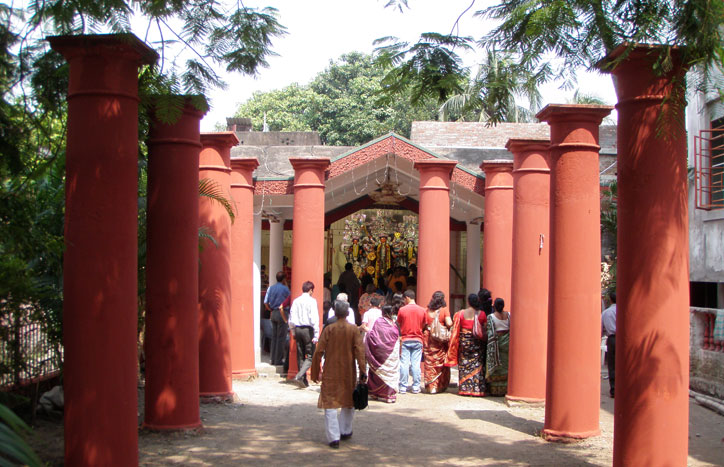Our expectation is that modern Kolkata as we now know it was shaped roughly 300 years ago. But, history is often inaccurately rendered. As it turns out, the history of Behala goes back much farther into the past than the rest of the city. Here is its captivating story.
Manasamangal-Kavya and Sati Behula
In the 12th Century, when this part of Bengal was still part of the extended mangrove delta, it was ruled by the Pala Kings. It was around this time that the Manasamangal-Kavya was composed. It is the oldest of the recorded Mangal Kavyas and retells the story of the Snake-goddess Manasa, who forced her way into the pantheon of Hindu Gods. The story begins with a conflict between Manasa and Chandradhar, a devoted Shaivite. Manasa believes if she can win over the devotion of as ardent a worshipper like Chandradhar, she might gain stature among the Gods. Instead, not only does the mortal Chandradhar refuse to worship her, he refuses even to acknowledge her as a Goddess. Burning with furious revenge, Manasa destroys Chandradhar’s seven ships, killing his seven sons. At this point, the youngest son’s widow undertakes a great journey seeking redemption. She sets sail on the Ganga in a boat with her husband’s deceased body – displaying great devotion and strength of character, she manages to awe Manasa and bring back all seven brothers back to life.
On her journey, Sati Behula was sailing down the Ganga toward the sea. This is centuries ago, when the Adiganga used to be a prominent tributary. The story goes that Behula picked a spot south of Kalighat to come ashore – this spot came to be known as Behula’s Ghat, and later, Behala.
Regional gods and local myths
Many other phonetic symmetries emerge from readings and interpretations of history. For instance, one theory suggests that the region was named Behala as a tribute to Goddess Chandi, who was also known as Bahula. The explanation is that during the 12th Century, Behala was populated mostly by beekeepers and fishermen who relied on the mangrove for their livelihood. The region was ruled then by the powerful Dhananjay Mitra, who is known as the first recorded Zamindar in the region. Mitra was also known to be a great devotee of the Goddess Chandi, lending some credence to this theory.
Some names survive the test of time
Whichever version of history one prefers to believe, it cannot be contested that Behala was a thriving settlement much, much before Calcutta was even conceived. This is supported by historical records which claim that Behala was a perpetually crowded trade centre as it lay on the route between two prominent pilgrimages – Kalighat and Gangasagar. The area was then a cluster of hamlets, all named with the same suffix ‘-behala.’ For instance, Bajarbehala, Borshebehala, Sarshoonbehala; some of which survive till present times, like, Rajarbaganbehala, Sahapurbehala, Naskarpurbehala, Santoshbatibehala, which still remain recorded in municipal registers.
Specific mentions to this region go as far back as Ptolemy, who labels the area in the 2nd Century AD, as ‘Basin Salsoona.’ The name Salsoona is probably an adulteration of Sarshoon, from Sarshoon Behala. Sarshoon Behala is where Basanta Roy, one of the Baro Bhuiyans (12 landlords) of Bengal, ruled the region. It appears that settlements in this region far outdate our expectations. In the 15th Century, Basanta Roy was unseated by the ruler of Jessore, Pratapaditya.
Following this, the Mughal Emperor Akbar intervened; he sent his trusted lieutenant Man Singh to stall Pratapaditya’s march. The ruler of Jessor was promptly put in his place, and a new ruler was installed in the halls of power – Lakshmikanta Gangopadhyay. In time, Akbar’s successor Jehangir would elevate Lakshmikanta to the Jagir of the 24 parganas, and of Midnapore. This accession came with the title of Roychowdhury, as he established his kingdom at Barisha. His legacy is important as the Savarna Roychowdhurys are known for commencing large-scale celebrations of Durga Puja and were also the landowners who provided significant amounts of land in Kalikata, Gobindapur, and Sitanuti under lease to the British East India Company.

Cut to: 2022. Now, Behala sits in the midst of a sprawling urban cityscape, adjacent to South Kolkata’s burgeoning residential boom in Joka. In the last few years, many real estate prospects have come up in the area – responding to the new metro line going as far south as Joka. Near Joka Metro is located Gems Group’s bungalow project, Gems Bougainvillas. Dedicated to only bungalow-living and open, natural spaces, this project offers 2bhk, 3bhk, 4bhk and 5bhk bungalows and villas. Discover more about our project, check out bungalow types at https://www.gemsbougainvillas.in/bungalow-types-at-bougainvillas/.
Sources: Get Bengal – Behala, Ptolemy’s world map






